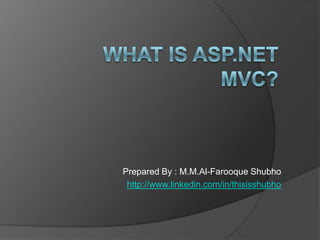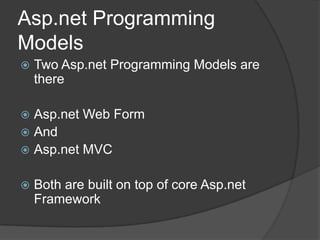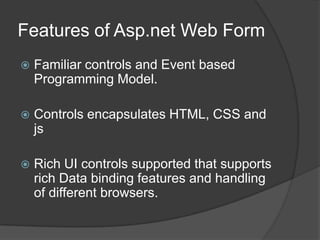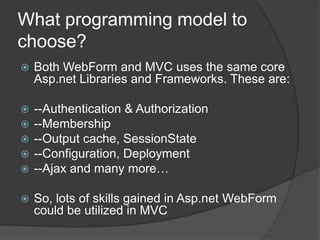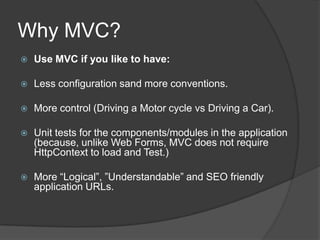Mvc Brief Overview
- 1. What is Asp.net MVC?Prepared By : M.M.Al-FarooqueShubhohttp://www.linkedin.com/in/thisisshubho
- 2. What is MVC?A âFrameworkâ built on top of Asp.net core framework.A framework that implements the core âModel, View and Controllerâ pattern where:Model = Things that encapsulates applicationâs Data and related LogicsView = Things that handles applicationâs data presentation. .Controller = Things that manages applicationâs Flow and Navigational logics.
- 3. Asp.net Programming ModelsTwo Asp.net Programming Models are thereAsp.net Web FormAndAsp.net MVCBoth are built on top of core Asp.net Framework
- 4. Features of Asp.net Web FormFamiliar controls and Event based Programming Model.Controls encapsulates HTML, CSS and jsRich UI controls supported that supports rich Data binding features and handling of different browsers.
- 5. Features of Asp.net MVCComfortable for Traditional web development nature.Total control on HTML markup.Supports Unit testing and TDD.Extremely flexible and Extensible.
- 6. What programming model to choose?Both WebForm and MVC uses the same core Asp.net Libraries and Frameworks. These are:--Authentication & Authorization--Membership--Output cache, SessionState--Configuration, Deployment--Ajax and many moreâĶSo, lots of skills gained in Asp.net WebForm could be utilized in MVC
- 7. Why MVC?Use MVC if you like to have:Less configuration sand more conventions.More control (Driving a Motor cycle vs Driving a Car).Unit tests for the components/modules in the application (because, unlike Web Forms, MVC does not require HttpContext to load and Test.)More âLogicalâ, âUnderstandableâ and SEO friendly application URLs.
- 9. How MVC works? Continued..1) Request arrives at the MVC Application.2) Based upon the Routing table configuration, the URL request is mapped to an Action inside an appropriate Controller.3) Controller accesses the Model to process the data with applying business logics.4) Model access/retrieves database/data source and process data and return result to the Action.5) Action populates the view with processed data and the View renders UI.
